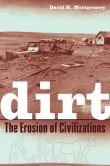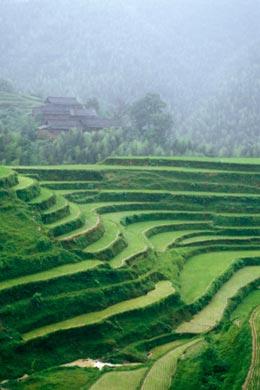U.S. scientists have measured the rate at which mountains make the raw material for molehills – and found that if the climate is rainy enough, soil gets made at an astonishing speed. And in the course of this natural conversion of rock to fertile farmland and forest loam, carbon is naturally removed from the atmosphere.
On the ridge tops of the New Zealand mountains, soil was being manufactured by chemical weathering (which is scientific shorthand for rain splashing on rock) at the rate of up to 2.5 mm a year.
“A couple of millimeters a year sounds pretty slow to anyone but a geologist,” said David R. Montgomery, one of the study authors. “Isaac measured two millimeters of soil production a year, so it would take just a dozen years to make an inch of soil. That’s shockingly fast for a geologist, because the conventional wisdom is it takes centuries.”
Rain Falling on Mountains Speeds Soil Creation and CO2 Removal
Monday, January 27, 2014
Saturday, January 18, 2014
Soil Microbes Alter DNA in Response to Warming
Scientists studying grasslands in Oklahoma have discovered that an increase of 2 degrees Celsius in the air temperature above the soil creates significant changes to the microbial ecosystem underground. Compared to a control group with no warming, plants in the warmer plots grew faster and higher, which put more carbon into the soil as the plants senesce. The microbial ecosystem responded by altering its DNA to enhance the ability to handle the excess carbon.
Soil Microbes Alter DNA in Response to Warming
Soil Microbes Alter DNA in Response to Warming
Monday, January 13, 2014
Climate Change Threatens East Africa’s Food Security
The report, East African Agriculture and Climate Change, published by the International Food Policy Research Institute (IFPRI), looks at threats to food supplies in 11 countries in East and Central Africa – Burundi, the Democratic Republic of Congo (DRC), Eritrea, Ethiopia, Kenya, Madagascar, Rwanda, Sudan, South Sudan, Tanzania and Uganda.
Agriculture accounts for more than 40 percent of gross domestic product across the region. The report says soil deficiencies in many parts mean agricultural productivity is falling.
Ecosystems are depleted, infrastructure is poor and there’s a lack of reliable information and policy coordination. Meanwhile weather systems are becoming more erratic and violent.
“Climate change will have far-reaching consequences for the poor and marginalized groups, among which the majority depend on agriculture for their livelihoods and have a lower capacity to adapt…this situation is likely to become more desperate and to threaten the very survival of the most vulnerable farmers as global warming continues,” says the study.
Climate Change Threatens East Africa’s Food Security
Agriculture accounts for more than 40 percent of gross domestic product across the region. The report says soil deficiencies in many parts mean agricultural productivity is falling.
Ecosystems are depleted, infrastructure is poor and there’s a lack of reliable information and policy coordination. Meanwhile weather systems are becoming more erratic and violent.
“Climate change will have far-reaching consequences for the poor and marginalized groups, among which the majority depend on agriculture for their livelihoods and have a lower capacity to adapt…this situation is likely to become more desperate and to threaten the very survival of the most vulnerable farmers as global warming continues,” says the study.
Climate Change Threatens East Africa’s Food Security
Sunday, January 12, 2014
Can America’s Grasslands Be Saved?
A study published early this year in the Proceedings of the National Academy of Sciences, found that 1.3 million acres of grassland had been converted to corn and soybeans between 2006 and 2011 in North Dakota, South Dakota, Nebraska, Minnesota and Iowa.
Native prairie — whose plants have deep and extensive root systems — is a very effective carbon sink if not cultivated, but plowing and converting that land to annual row crops leads to the emission of 20 to 75 metric tons of carbon dioxide equivalent per acre. As a point of comparison, a typical passenger car emits about 5.1 tons of carbon dioxide a year. Even if that converted land is devoted fully to the production of corn for ethanol that replaces fossil fuels, the study found that it would take 30 years to make up for the loss of carbon sequestration.
Can America’s Grasslands Be Saved?
Native prairie — whose plants have deep and extensive root systems — is a very effective carbon sink if not cultivated, but plowing and converting that land to annual row crops leads to the emission of 20 to 75 metric tons of carbon dioxide equivalent per acre. As a point of comparison, a typical passenger car emits about 5.1 tons of carbon dioxide a year. Even if that converted land is devoted fully to the production of corn for ethanol that replaces fossil fuels, the study found that it would take 30 years to make up for the loss of carbon sequestration.
Can America’s Grasslands Be Saved?
A Warming Planet Will Soon Produce Water Shortages, Scattered but More Severe and Lasting, that May Double Its Effects on Agriculture
Water shortages already put stress on people's lives in many countries today. Climate change due to unabated greenhouse gas emissions is likely to confront 40 percent more people with chronic water scarcity within a few decades.
A new analysis combining climate, agricultural, and hydrological models finds that shortages of freshwater used for irrigation could double the detrimental effects of climate change on agriculture.
Given the present trajectory of greenhouse gas emissions, agricultural models estimate that climate change will directly reduce food production from maize, soybeans, wheat and rice by as much as 43 percent by the end of the 21st century. But hydrological models looking at the effect of warming climate on freshwater supplies project further agricultural losses, due to the reversion of 20 to 60 million hectares of currently irrigated fields back to rain-fed crops.
A Warming Planet Will Soon Produce Water Shortages
A new analysis combining climate, agricultural, and hydrological models finds that shortages of freshwater used for irrigation could double the detrimental effects of climate change on agriculture.
Given the present trajectory of greenhouse gas emissions, agricultural models estimate that climate change will directly reduce food production from maize, soybeans, wheat and rice by as much as 43 percent by the end of the 21st century. But hydrological models looking at the effect of warming climate on freshwater supplies project further agricultural losses, due to the reversion of 20 to 60 million hectares of currently irrigated fields back to rain-fed crops.
A Warming Planet Will Soon Produce Water Shortages
Saturday, January 11, 2014
Fungi May Determine the Future of Soil Carbon
Soil contains more carbon than air and plants combined. This means that even a minor change in soil carbon could have major implications for the Earth's atmosphere and climate. New research points to an unexpected driver of soil carbon content: fungi.
Fungi May Determine the Future of Soil Carbon
Fungi May Determine the Future of Soil Carbon
China Cuts Methane Emissions from Rice Fields
Simple changes to farming practices in China have slashed the amount of methane released from rice fields, researchers say. Paddy fields account for around 20% of human-related emissions of methane — a potent greenhouse gas.
The team found that draining paddy fields in the middle of the rice-growing season — a practice that most Chinese farmers have adopted since the 1980s because it increases rice yields and saves water — stopped most of the methane release from the field.
China Cuts Methane Emissions from Rice Fields
The team found that draining paddy fields in the middle of the rice-growing season — a practice that most Chinese farmers have adopted since the 1980s because it increases rice yields and saves water — stopped most of the methane release from the field.
China Cuts Methane Emissions from Rice Fields
Subscribe to:
Posts (Atom)







